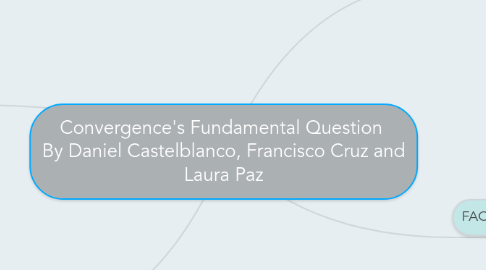
1. CONVERGENCE PERSPECTIVES
1.1. The journalistic ideal: convergence brings new ways to absolve news on multiple-plataforms.
1.1.1. Improve the quality of the content More and better tools
1.2. Business ideal: new form of business where everyone co-coperate to increase productivity.
1.3. Editorial managers and publishers: journalist have to produce more content for less amount of money and make business model attractive.
1.4. Andrew Nachison: owners of newspapers see their product as a business tool
2. SOME FACTORS AND CONCLUTIONS
2.1. Driving convergence
2.1.1. Market fragmentation: media companies are competing for de audience.
2.1.2. Business of journalism: getting as many people as possible to look at media products (eyeballs)
2.2. Journalist and managers says...
2.2.1. convergence involves a radical change in aproach.
3. ¿WHAT IS CONVERGENCE?
3.1. More than one definition
3.1.1. USA: team work between journalist's and reporters.
3.1.2. Rich Gordon: five forms of convergence
3.1.2.1. Ownership: between large companies
3.1.2.2. Tactical: partnership between the US media
3.1.2.3. Structural: re-organize the newsroom
3.1.2.4. Information-gathering: multi skilled reporters needed
3.1.2.5. Storytelling: desktop computers, interactive television and portable devices. (technology evolution)
3.1.3. Generalized: way to protect the position on the market and how the reporter must be specialized on specific topic to the point that his expertise be evident.
3.1.4. Author
4. FACTS AND HYPOTHESIS
4.1. Future
4.1.1. New habits of the news public, where journalist's must go. Technology advances allow's convergence be.
4.2. Barriers
4.2.1. Easy: same owner and flexible cultures. Difficult: different owners, multiple managers.
4.3. Keyfactors
4.3.1. Intranet, cultural relationships, flow information (multiple platforms) and change of mindset (minds of editorial managers).
